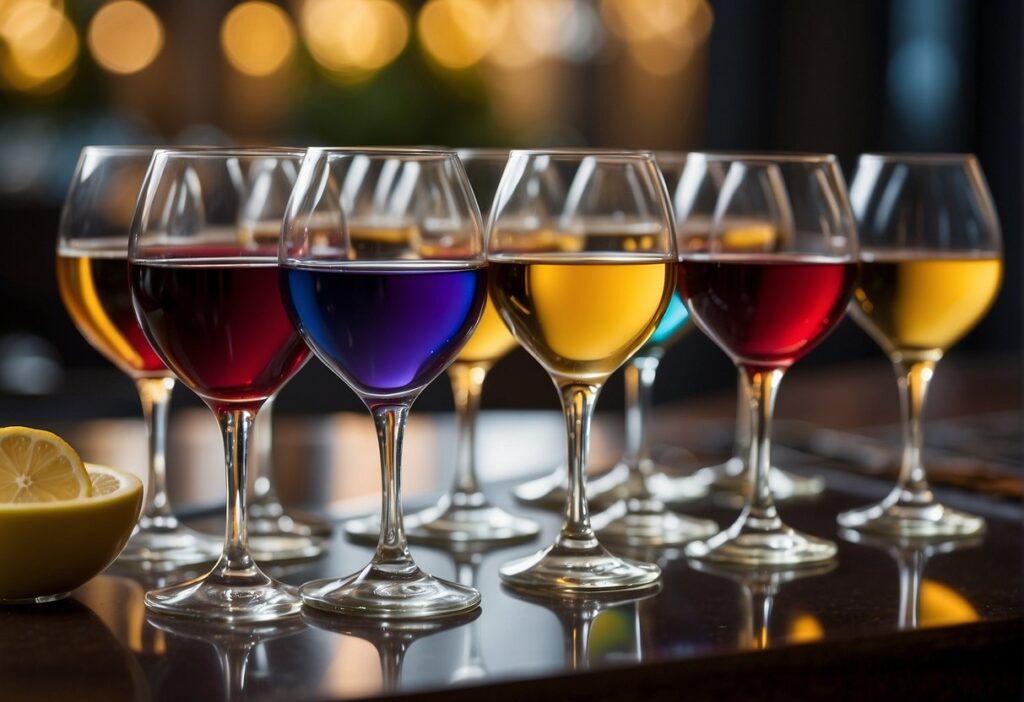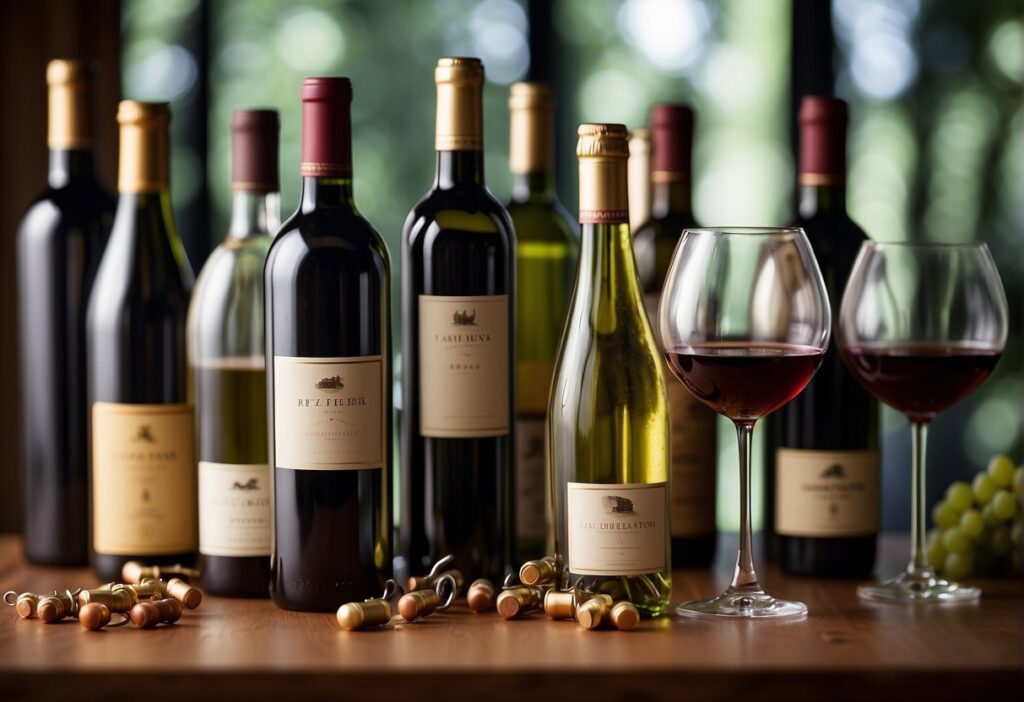Wine varietals are distinct types of wine characterized by the grape variety used in their creation. Understanding these varietals is essential as they each carry unique flavors, aromas, and textures that contribute to the wine’s identity.
From rich, robust reds to light, crisp whites, each varietal offers a unique tasting experience. For example, when you sip a glass of Cabernet Sauvignon, you expect bold, tannic flavors, whereas a taste of Sauvignon Blanc should reveal tart, zesty notes.
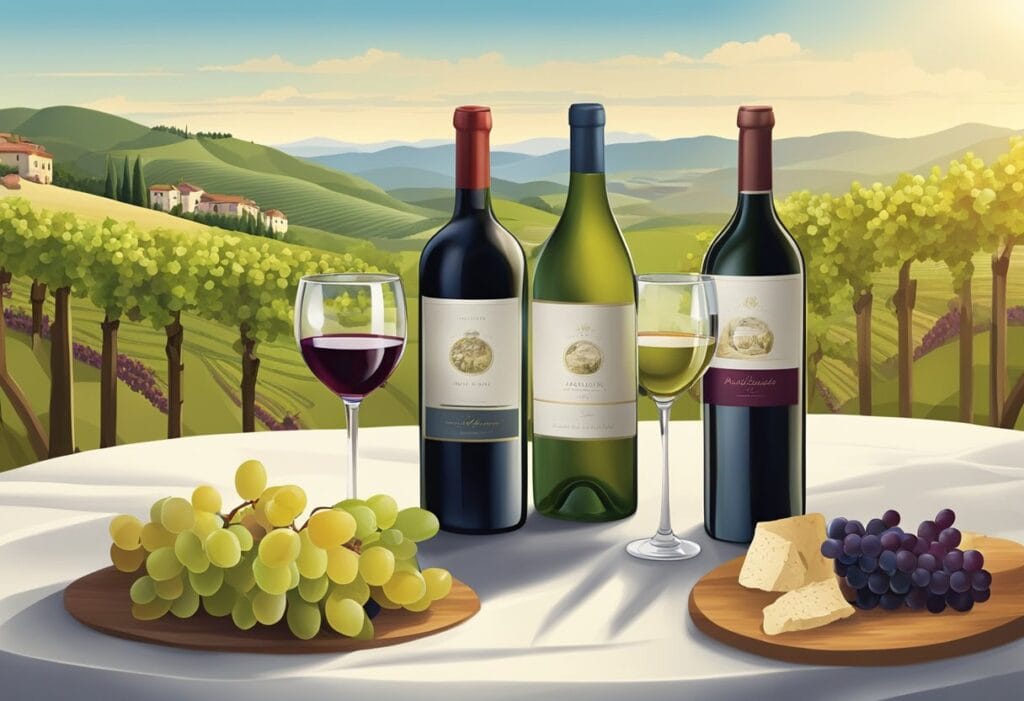
Given the vast selection available, familiarity with major varietals such as Merlot, Chardonnay, and Pinot Noir can enrich your appreciation of wine. The flavors you encounter in wine are profoundly influenced by the region where the grapes are grown, the winemaking process, and the specific characteristics of each grape variety.
While red wines like Shiraz and white wines like Riesling have distinct profiles, rosé, sparkling, and blush wines provide even more diversity in flavor and style. Your journey into wine varietals may also lead you to explore the art of food pairing, the intricacies of wine production and blending, and even the cultural significance of wine throughout history.
Key Takeaways
- Wine varietals are defined by the grape types from which they are made, each offering a distinct set of flavors.
- Familiarity with popular red and white varietals can enhance your wine tasting experiences and food pairings.
- Exploring wine involves not just the varieties themselves, but also their cultural, historical, and production contexts.
Understanding Wine Varietals
Wine varietals represent the distinct types of grape varieties used in the production of wine. Each varietal carries unique flavor profiles, which contribute to the overall character of the wine. When you choose a wine varietal, you are experiencing the expression of a particular grape, shaped by its terroir and the winemaker’s craft.
Grape Varieties
There are hundreds of different wine grapes, each offering a unique taste sensation. For instance:
- Cabernet Sauvignon: Bold and robust with dark fruit flavors
- Chardonnay: Often buttery with a hint of oak and tropical fruits
- Merlot: Soft and velvety, featuring red fruits like cherries and plums
Flavor Profiles
Every wine grape has a spectrum of flavors, impacted by climate and soil. For example, Pinot Noir from a cool climate might present flavors of strawberries and earth, while the same varietal from a warmer region often gives off jammy and spicy notes.
Food Pairing
The varietal you choose can elevate your dining experience. Lighter wines like Sauvignon Blanc are perfect with seafood, whereas fuller-bodied reds such as Syrah pair excellently with hearty meats.
Blends
Sometimes, winemakers create blends using multiple varietals to achieve a specific flavor complexity. A classic Bordeaux blend combines grapes like Cabernet Franc, which imparts finesse, with Merlot and Cabernet Sauvignon for a balanced and full-bodied experience.
As you explore different wines, pay attention to these details. They will guide you to discover varietals that not only match your taste preference but also complement your meals and occasions.
Major Red Wine Varietals
Navigating the range of red wine varietals, you’ll encounter bold flavors and diverse profiles. Each varietal presents unique characteristics, from the tannic punch of a Cabernet Sauvignon to the more subtle and fruity notes of a Merlot.
Cabernet Sauvignon
Cabernet Sauvignon is a full-bodied red wine known for its high tannins and deep, dark fruit flavors. When you’re enjoying a glass of Cabernet, expect robust notes of blackcurrant and cassis with a hint of oak. It’s an excellent pairing with red meat.
Merlot
Merlot offers a softer, more rounded experience with flavors often reminiscent of plum and other red fruits. It’s a versatile wine that maintains a fruity profile with a smooth finish, making Merlot a friendly varietal for a broad audience.
Pinot Noir
Pinot Noir, hailing primarily from the Burgundy region of France, is known for its lighter body and aroma filled with cherry and earthy undertones. You will find that Pinot Noir often exhibits a subtle complexity with both floral and herbaceous layers.
Syrah/Shiraz
Whether you’re tasting a Syrah or a Shiraz, you’re actually savoring the same grape under different names. Originating from France but also prevalent in Australia, this varietal typically offers spicy pepper notes with a jammy berry essence.
Zinfandel
Zinfandel flourishes in California’s vineyards and is the go-to for wine enthusiasts who adore a fruit-forward profile. With zesty blackberry and often a spicy character, Zinfandel can range from medium- to full-bodied and pairs excellently with bold, hearty foods.
Major Red Wine Varietals
In this section, you’ll explore some of the most celebrated red wine varietals, each with its unique profile ranging from fruity to floral, spicy to earthy. Learn about their tannin levels, flavor notes, and ideal food pairings.
Malbec
Malbec is best known for its deep color and intense dark fruit flavors. Originating from France, it has found a fervent following in Argentina, where the varietal has become synonymous with Argentine identity. Malbec wines are full-bodied, typically with a high level of tannins and notes of plum and blackberry, making them excellent pairings for red meat.
Grenache
Grenache is recognized for its berry and spice characteristics. It thrives in Spain and the south of France. Wines from this varietal are often medium to full-bodied and exhibit a expressively fruity profile with a soft texture of tannins, making them versatile for food pairing, especially with spicy dishes.
Sangiovese
The Sangiovese grape is the pride of Italy, famously known for creating Chianti wines. It can range in flavor from earthy and herbal to richly fruity with cherry and red fruit notes. Notably high in tannins and acidity, Sangiovese pairs beautifully with Italian cuisine, particularly dishes with tomato-based sauces.
Tempranillo
Tempranillo, Spain’s flagship varietal, is particularly famous in the Rioja and Ribera del Duero regions. These wines often have a balance of red fruit and oak influence, with undertones of leather and tobacco, providing a savory contrast to the fruit. Tempranillo pairs well with roasted meats and aged cheeses.
Nebbiolo
The noble Nebbiolo grape is responsible for some of Italy’s most revered wines, including Barolo and Barbaresco. Noted for its high tannins and marked acidity, Nebbiolo presents complex flavors of red fruits, roses, and tar. These wines are robust and structured, making them ideal candidates for aging.
Major Red Wine Varietals
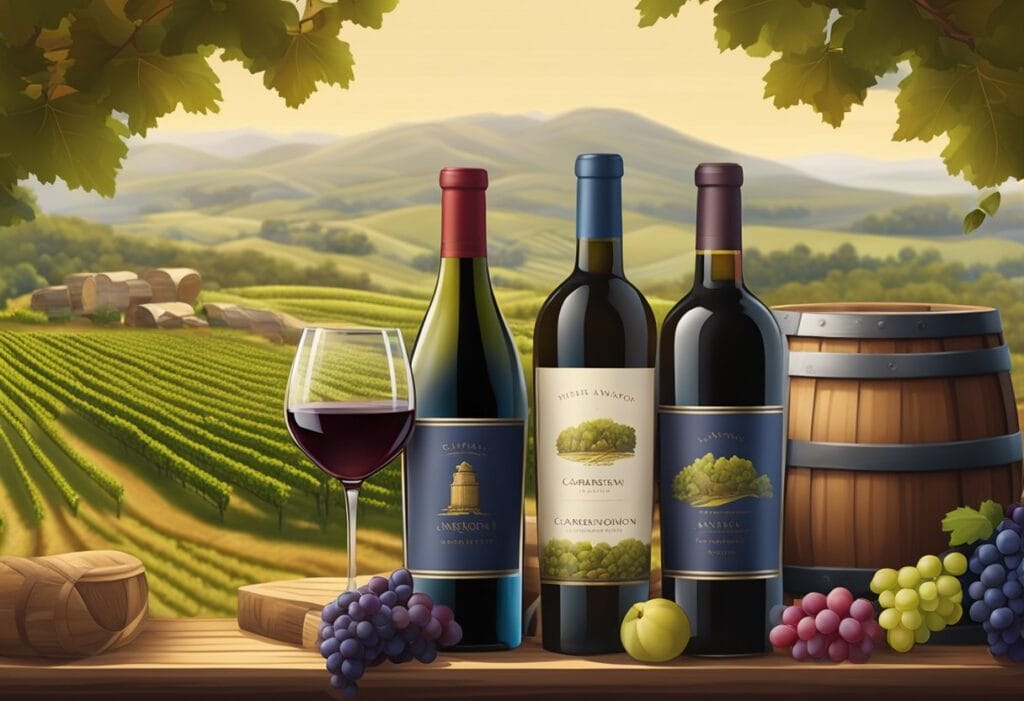
In your exploration of red wines, you’ll encounter a range of varietals each with distinctive flavors, from the fruity notes of a Pinot Noir to the bold tannins of a Cabernet Sauvignon. Understanding these varietals will enrich your wine experience, pairing perfectly with everything from red meat to a cozy evening in.
Petite Sirah
Petite Sirah is known for its full-bodied profile and a bold palette that includes jammy flavors and an abundance of tannins. It often carries notes of blackberry and dark fruit flavors, making it a hearty choice for red wine enthusiasts.
Gamay
Gamay, primarily found in Beaujolais wines, offers a lighter body with distinctive floral and red fruits notes. This varietal is celebrated for its bright acidity and is typically best enjoyed young.
Cabernet Franc
Cabernet Franc thrives in the Loire Valley of France and is known for its herbal notes, often complemented by a hint of spice and floral overtones. While it shares similarities with Cabernet Sauvignon, it usually presents a more subtle and earthy profile.
Mourvedre
Mourvedre is a robust red wine that exhibits gamey and earth notes with a side of spicy and fruity characteristics. Often used in blends, Mourvedre brings complexity and warm spice to the palate.
Pinotage
Originating from South Africa, Pinotage combines the best of Pinot Noir and Cinsault, offering a unique taste profile with smoky, earthy, and occasionally fruity undertones. Pinotage has a distinctive profile that is often described as having a smoky flavor.
Major White Wine Varietals
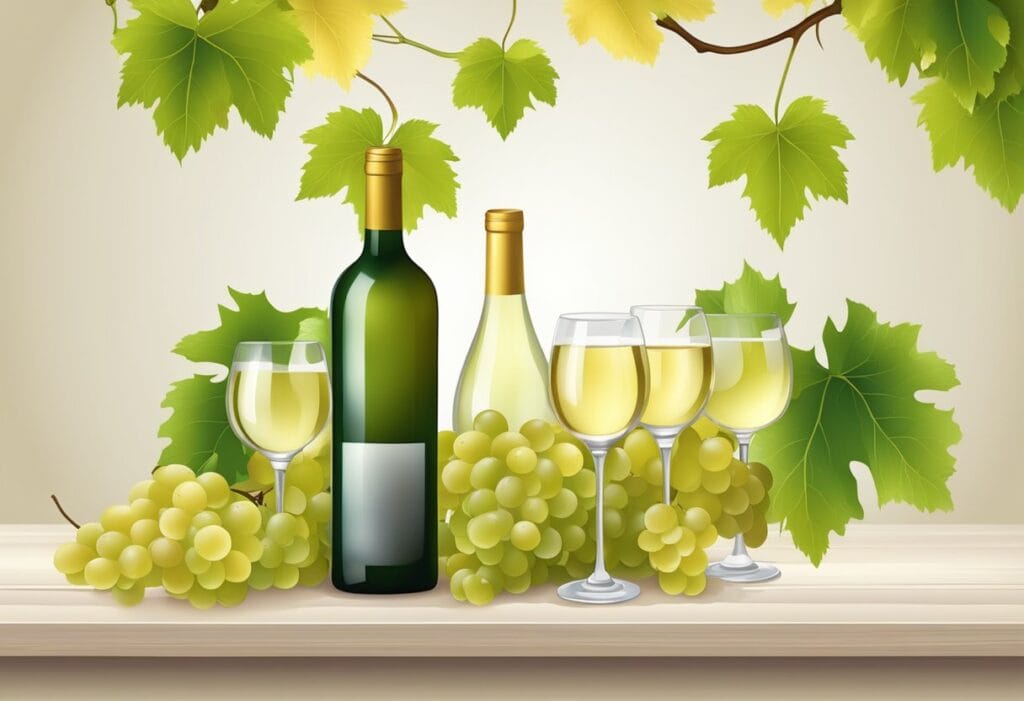
When you explore the world of white wines, you’ll encounter a range of flavors and styles. From light and crisp to full-bodied and oaky, each varietal offers a unique tasting experience. Here’s a look at some of the major white wine varietals you should know.
Chardonnay
Chardonnay is a versatile white wine that can range from clean and crisp to rich and buttery. Oaked versions tend to have a heavier body and creamy texture, often with hints of vanilla and a buttery finish. The unoaked ones keep their crisp and fresh fruit flavors to the forefront. Regions renowned for Chardonnay include Burgundy and California.
Riesling
Riesling hails mainly from Germany, known for its aromatic qualities and high acidity. It can display a bouquet that spans from floral notes to apple, with an underlying minerality. While some assume Riesling is always sweet, it actually comes in various styles, from dry to sweet.
Sauvignon Blanc
Sauvignon Blanc often presents vivid citrus and green herbal flavors, making it a refreshing choice. Notable regions producing Savignon Blanc are New Zealand and the Loire Valley, where it expresses a range of fruit flavors and can have a grassy note.
Pinot Gris/Grigio
Known as Pinot Gris in France and Pinot Grigio in Italy, this varietal typically produces light-bodied wines that can vary broadly in flavor. Italian Pinot Grigio is often light and zesty, while French Pinot Gris from Alsace is fuller-bodied with notes of ripe melon.
Chenin Blanc
Chenin Blanc is incredibly versatile, capable of producing wines that span from sweet to dry. Originating from France’s Loire Valley, it’s known for its apple-like flavors and ability to age well. In South Africa, where it’s also widely grown, it displays a more tropical fruit profile.
Major White Wine Varietals
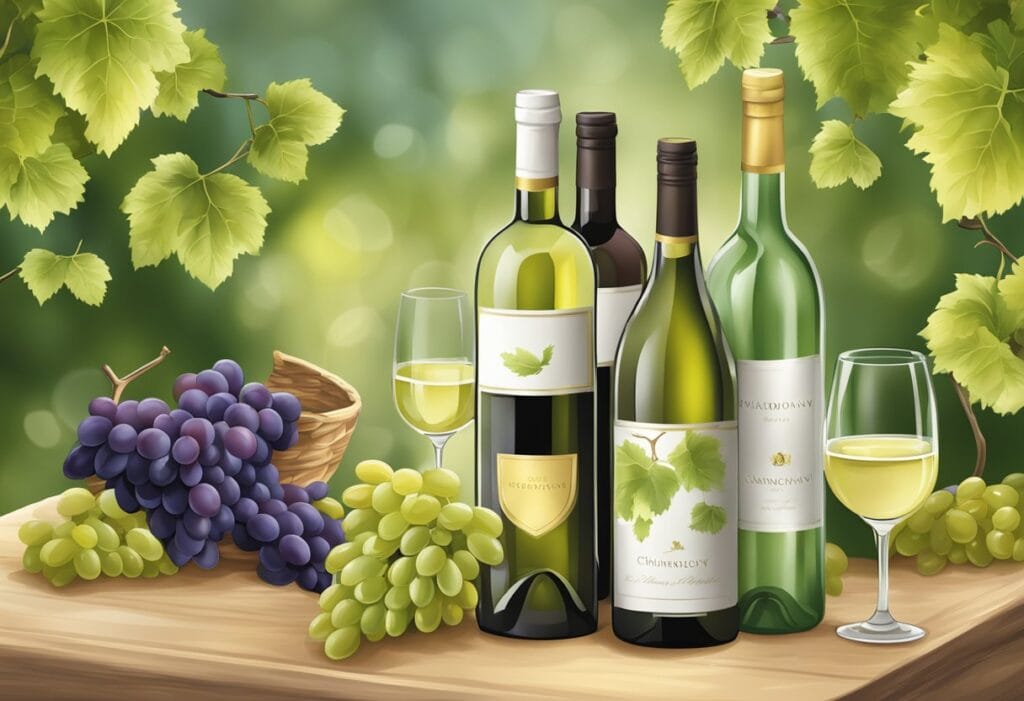
In this section, you’ll discover the distinct characteristics of major white wine varietals, each offering a unique flavor profile and aromatic qualities that contribute to the vast world of white wines.
Viognier
Viognier is known for its floral and perfume aromas, displaying flavors of peach and tangerine. It often presents a silky, medium-body that can be quite luscious compared to lighter-bodied whites.
Gewürztraminer
An aromatic treasure, Gewürztraminer shines with rose, lychee, and sometimes spicy notes. Its intense flavor can range from dry to sweet, making it a versatile pairing for a range of cuisines.
Sémillon
Often found in blends, Sémillon contributes a waxy texture and flavors of fig and citrus. It has the remarkable ability to age, developing intriguing complex flavors over time.
Albariño
Hailing from Spain, Albariño offers a zesty and refreshing experience. Your palate will be greeted with flavors of lemon, grapefruit, and sometimes melon, coupled with a bright acidity that makes it an ideal match for seafood.
Moscato
For those with a sweet tooth, Moscato provides delicate floral notes along with a pleasing sweetness. This light varietal often carries hints of orange blossom and nectarine, perfect for sipping on a warm day or pairing with desserts.
Understanding Regions and Appellations
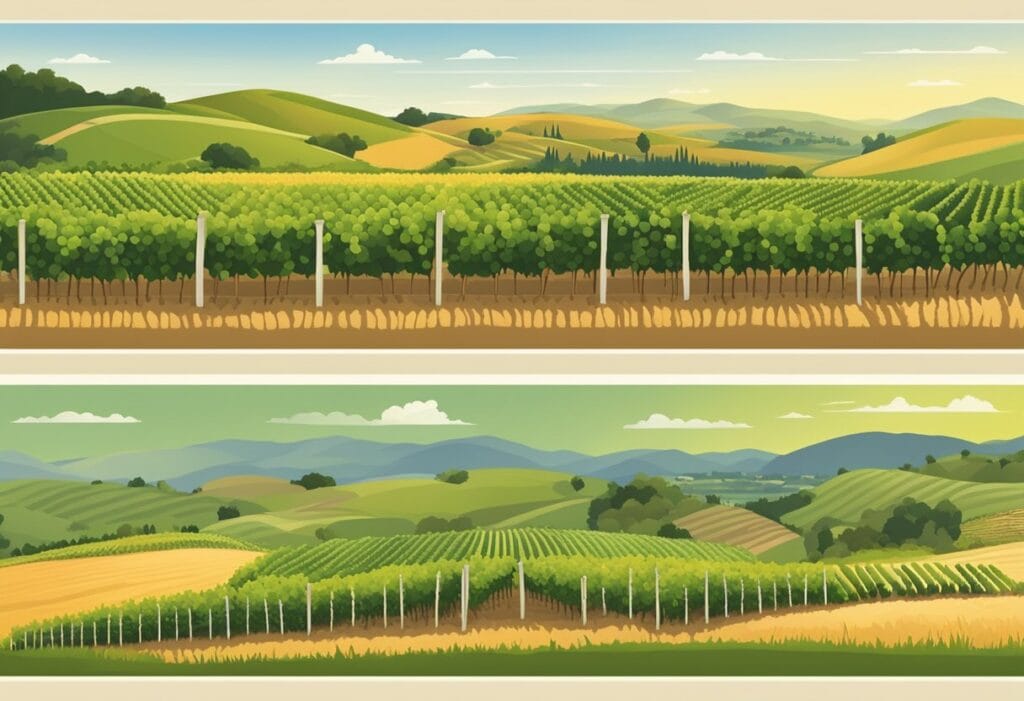
In exploring the diverse world of wine, you’ll encounter unique flavors and characteristics shaped by the appellations and regions of origin. Recognizing the impact of climate and terroir is crucial as you navigate through wines from the Old World to the New.
Old World Wine Regions
Old World wines refer to those from regions where winemaking (and often viticulture) originated. These include countries like France, Italy, Spain, and Germany. The concept of terroir plays a significant role here, with strict regulations governing winemaking practices and grape varieties.
- France: Home to some of the world’s most prestigious appellations, including Burgundy, known for its Pinot Noir and Chardonnay; Bordeaux, revered for its red wine blends; and the Rhône Valley, which produces a variety of reds from Syrah and Grenache. Each region is closely tied to its climate and geography.
- Italy: Famous for its broad diversity of wines, from the Nebbiolo of the Piedmont region to the Sangiovese of Tuscany. Italian appellations such as DOCG and DOC ensure wine quality and regional authenticity.
- Spain & Germany: Known for their unique varietals and wine styles, influenced heavily by regional climate conditions. Spain’s Rioja and Germany’s Mosel highlight the European commitment to appellation systems.
New World Wine Regions
The New World, by contrast, typically refers to countries that are newer to wine production on the global stage. These include the United States, Australia, South Africa, New Zealand, Argentina, and Chile. Here, innovation often drives winemaking, with a focus on varietal labeling.
- United States: The Napa Valley stands out with a Mediterranean climate ideal for Cabernet Sauvignon. Despite a less regulated approach to appellations, regions like Sonoma and Willamette Valley are signifiers of quality and style.
- Australia & New Zealand: Offer a range of climates from the warm Barossa Valley, known for Shiraz, to the cooler Marlborough region, acclaimed for its Sauvignon Blanc.
- South America: Argentina’s Mendoza and Chile’s Central Valley capitalize on altitude and coastal influences to produce wines with distinct profiles, expanding their acclaim on the international stage.
Notable Wine Regions
Dedication to preserving the unique attributes of wine is evident through recognized appellations across the globe. Each notable region is marked by its adherence to quality and expression of terroir.
- Loire Valley: Renowned for its crisp white wines like Sancerre, the Loire Valley in France emphasizes the importance of climate and soil types across its appellations.
- Piedmont Region: This area in Italy has gained fame for its Barolo and Barbaresco wines, rooted deeply in tradition and the distinct climate of the region.
- Bordeaux & Burgundy: Epitomize the essence of French appellations, upholding centuries-old methods that echo through their prestigious wines.
By recognizing these regional differences, you enhance your understanding and appreciation for the wines produced within these appellations.
Pairing Wine with Food
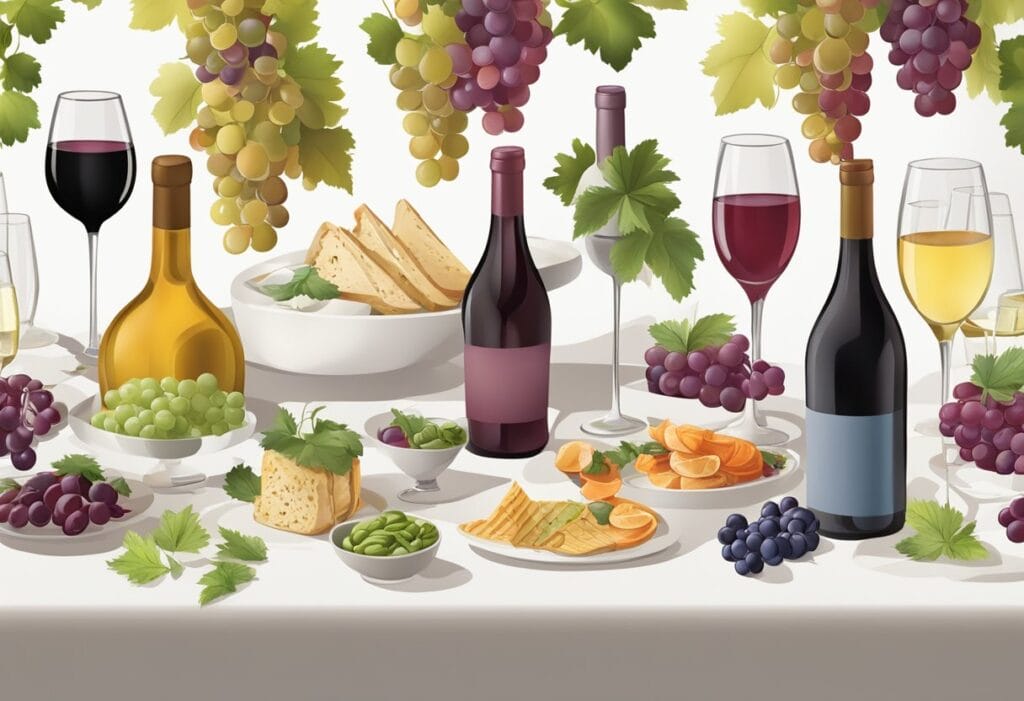
When you’re exploring wine and food pairing, it’s crucial to consider the main flavors of the dish. Red meat, such as a robust beef steak, pairs well with full-bodied red wines like Cabernet Sauvignon or Malbec, which complement the richness of the meat. The tannins in these wines cut through the fat, enhancing both the dish and the drink.
Pairing wine with lamb involves medium-bodied reds like Pinot Noir or Zinfandel. These wines balance the slightly gamey flavor of lamb, especially when the lamb is seasoned with herbs or black pepper.
For lighter meats like chicken, opt for white wines such as Chardonnay or a light Pinot Noir. The wine should match the weight and preparation of the poultry; for example, an oaked Chardonnay pairs wonderfully with a creamy chicken recipe.
When it comes to cheese, soft cheeses like brie and goat cheese go hand in hand with acidic white wines like Sauvignon Blanc, which cut through the creaminess. Conversely, an aged cheddar, with its bold flavors, can stand up to a rich red wine, such as a Cabernet.
For further exploration of pairings, consider reading articles that delve into the subtle nuances or explore recipes that offer specific wine pairing suggestions. Websites like Wine Folly provide a good starting point for understanding the basics. As always, the key to successful pairings is balancing the intensity of your wine with the flavors of your food.
Wine Production and Varietal Blending
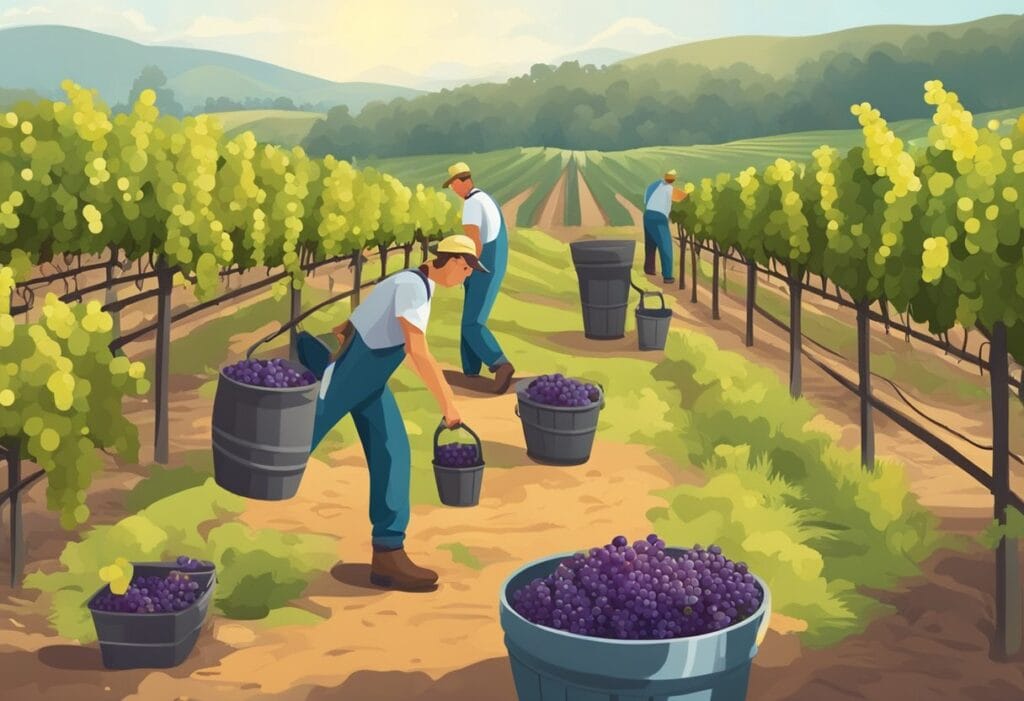
Wine production is a meticulous process that involves the careful selection and combination of grape varieties. Varietal blending is a crucial component, allowing winemakers like Robert Mondavi to innovate and produce diverse styles of table wine.
When creating a blend, you must consider the character of each varietal. Certain grapes may add more body to a wine, while others impart subtle aromas or provide a backbone of tannins. For example, blending Cabernet Sauvignon with Merlot gives a balance between structure and softness.
Here’s a simplified overview of the blending process in wine making:
- Harvest grapes considering their alcohol potential.
- Ferment each varietal separately.
- Taste and test each wine for its unique profile.
- Combine wines in trial blends to find the perfect match.
- Age the final blend to achieve desired complexity.
Remember: not all wines are blends. Single varietal wines focus on the expression of one grape type, highlighting its uniqueness.
In wine blending, you’re not just mixing; you’re coaxing out the best characteristics of multiple varietals to create a harmonious end product. It requires a deep understanding of each grape’s contribution to the wine’s flavor, structure, and longevity.
Whether you prefer the vibrant simplicity of a single varietal or the layered complexity of a blend, appreciating the craftsmanship behind each bottle adds to your enjoyment of this timeless beverage.
Storing and Serving Wine
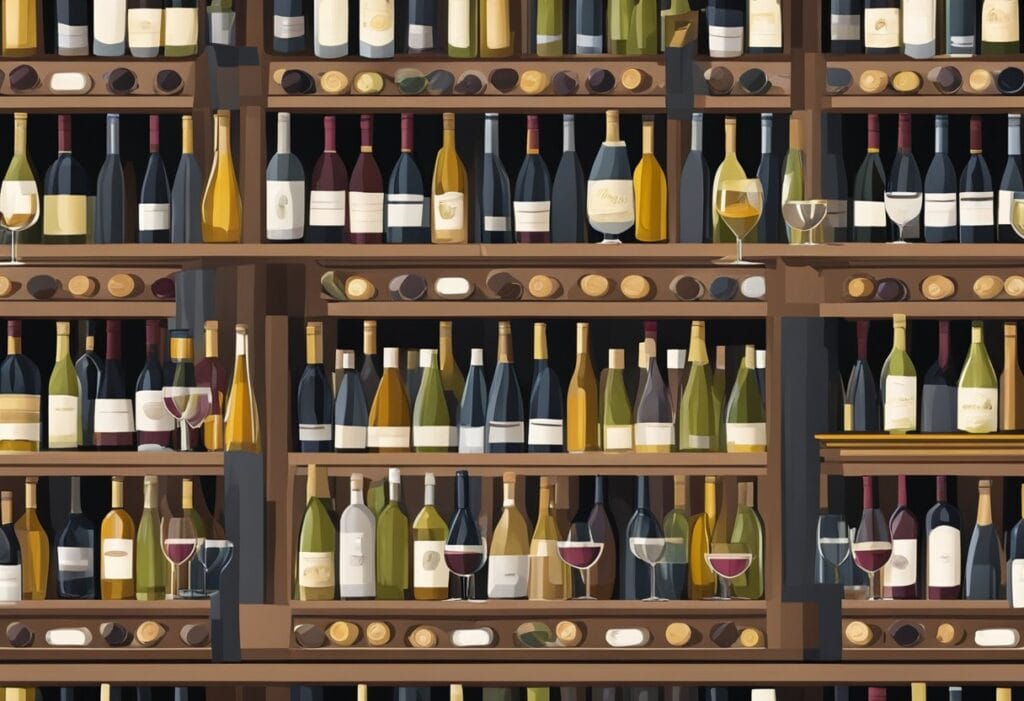
When storing wine, maintain a consistent temperature typically between 45-65°F. Excessive heat over 70°F may cause premature aging or even “cook” the wine, weakening the aromas and flavors. For short-term storage of under six months, this temperature range remains suitable.
Champagne and rosé require specific attention. Keep them away from light and vibration, ideally in a wine cooler or cellar. These conditions prevent deterioration and preserve their unique characteristics.
For serving temperature, follow these guidelines to ensure the best experience:
| Wine Type | Temperature |
|---|---|
| Champagne | 46-50°F |
| Light Rosé | 46-55°F |
| Bold Rosé | 50-60°F |
Serve wines at their optimal temperatures to highlight fruit, acid, and tannins adequately. For instance, a light rosé will offer its best qualities slightly chilled, while a bold rosé might need to be a tad warmer to express its full range of flavors.
Remember: Store bottles horizontally to keep the corks moist, which is especially key for wines meant for aging. Rotate your stock regularly to drink older vintages before they pass their prime, giving you the best from each bottle.
Wine Tasting and Descriptors

During wine tasting, your goal is to identify and articulate the various characteristics of a wine. To enhance your tasting experience, it’s essential to familiarize yourself with common wine descriptors.
- Tannic: You might describe a wine as tannic if it has a drying effect on your mouth. This sensation, often associated with red wines, comes from tannins, which are compounds present in grape skins, seeds, and stems.
- Lean: When a wine feels light-bodied or not overly rich, it can be described as lean. These wines usually have higher acidity and less sugar.
Descriptors for wine flavors are extremely varied:
- Melon: In some white wines, you may detect a fresh, fruity melon note.
- Black Cherry: Red wines, especially those that are fuller-bodied, often have a deep, sweet berry note like black cherry.
- Floral: This description applies to wines that carry the aroma of flowers, which might be noticeable in both the smell and taste.
- Herbal Notes: These are the green, sometimes earthy flavors that can remind you of fresh or dried herbs.
As you taste wines, think about these terms and how they apply to what you’re experiencing. With practice, your descriptive abilities will enhance your enjoyment and appreciation of different wine varietals.
Exploring Less Common Varietals
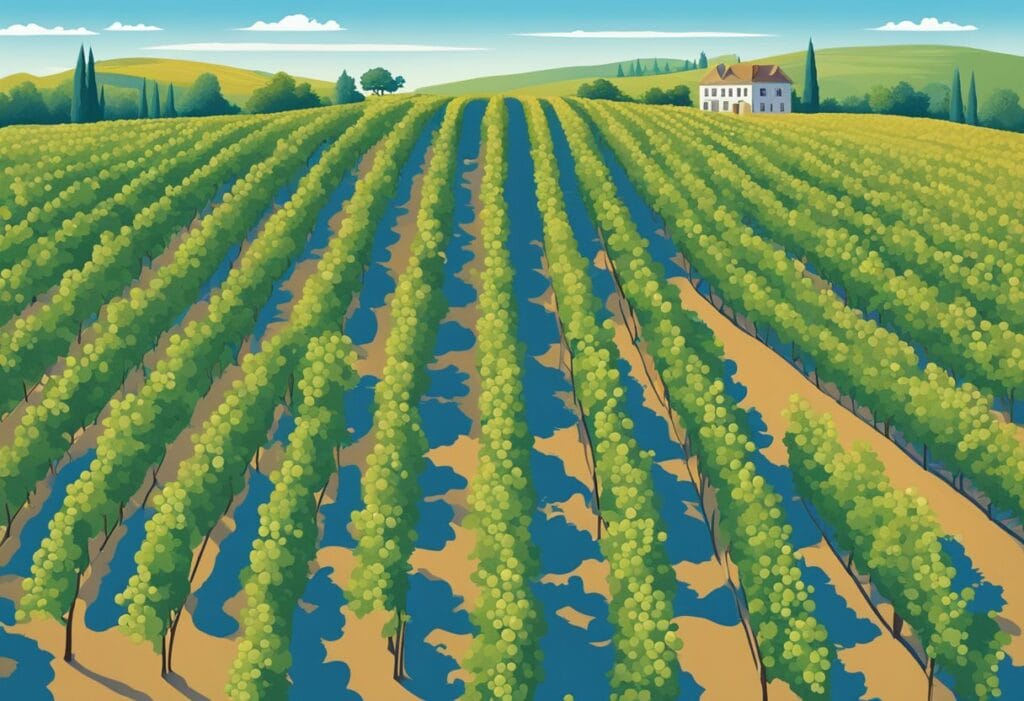
As you delve into the world of wines, you’ll find that each varietal offers a unique characteristic that sets it apart. Discover the hidden gems among red and white varietals, broadening your wine exploration.
Lesser-Known Red Varietals
While you may be familiar with Cabernet Sauvignon and Merlot, there’s a whole spectrum of red varietals that offer a distinct tasting experience. The Barbera varietal, often overshadowed, delivers a sumptuous combination of cherry flavors and acidity, making it an excellent choice for food pairing. Expand your palate further with Carménère, once a major Bordeaux grape but now flourishing in Chile, it is celebrated for its spicy notes and smooth finish.
Another unique option is Dolcetto, an Italian grape with gentle tannins and a fruit-forward profile. Despite its name translating to ‘little sweet one,’ Dolcetto wines are typically dry and boast a range of berry flavors.
Lesser-Known White Varietals
Moving to white wines, escape the usual picks and try a bottle of Grüner Veltliner. This Austrian native stands out with its peppery bite, zesty citrus, and sometimes a hint of minerality. It’s a refreshing change of pace and pairs wonderfully with a variety of foods.
Not to be left out are the versatile Rhône varietals Marsanne and Roussanne. These grapes, either blended or on their own, produce full-bodied wines that can range from rich and nutty to floral and elegant. Marsanne is known for its pear and spice flavors, while Roussanne offers a more delicate profile with notes of honey and tea.
Wine Legislation and Labeling
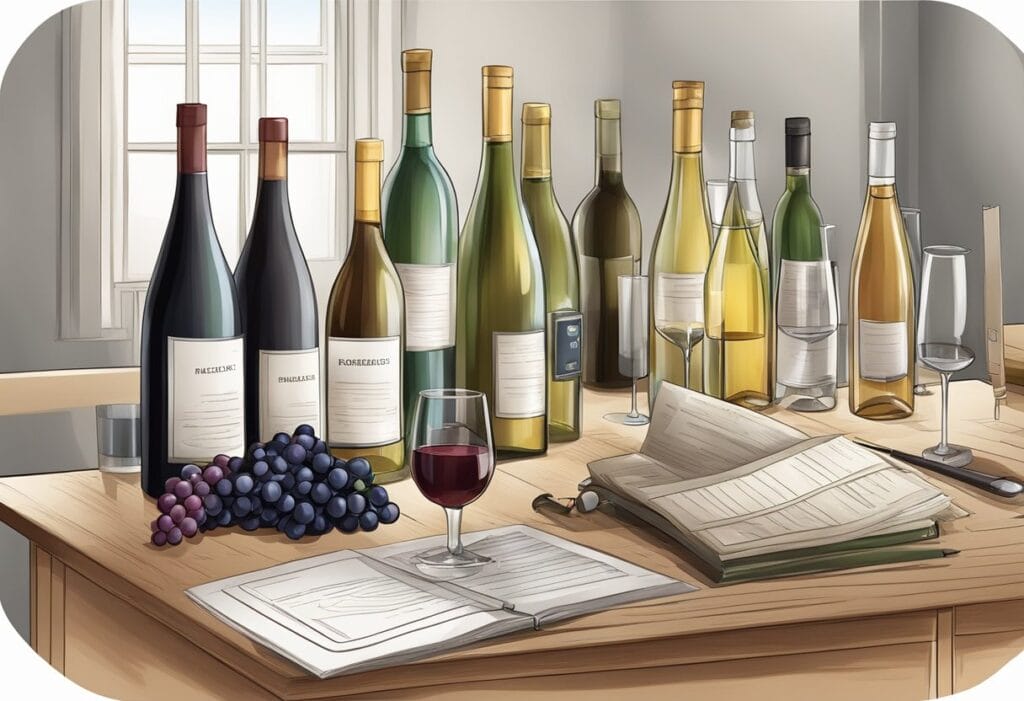
Wine legislation is pivotal in maintaining quality and authenticity within the industry. Understanding your wine labeling is crucial, as these regulations are not only a reflection of the law but also serve to inform and protect you as a consumer.
In the United States, the Alcohol and Tobacco Tax and Trade Bureau (TTB) sets forth specific requirements for wine labels. You must comply with these rules to ensure your wine is marketable and legally compliant.
For instance, if you’re labeling a wine based on grape variety, at least 75 percent of the wine must be made from that named grape, and this figure can vary regionally.
Internationally, you might encounter the terms Protected Designation of Origin (PDO) and Controlled Designation of Origin (CDO). These designations are European-specific and are essential for wines produced in those regions. They guarantee that the wine comes from the area on the label and meets certain quality and production standards.
| Designation | Purpose |
|---|---|
| PDO | Protects authentic regional foods |
| CDO | Regulates quality and origin |
When encountering European wines, understanding these terms will enhance your appreciation of the wine’s heritage and quality. Your awareness of these laws supports the integrity of the wine industry and ensures that your selection is a genuine representation of its origin.
The Future of Wine Varietals
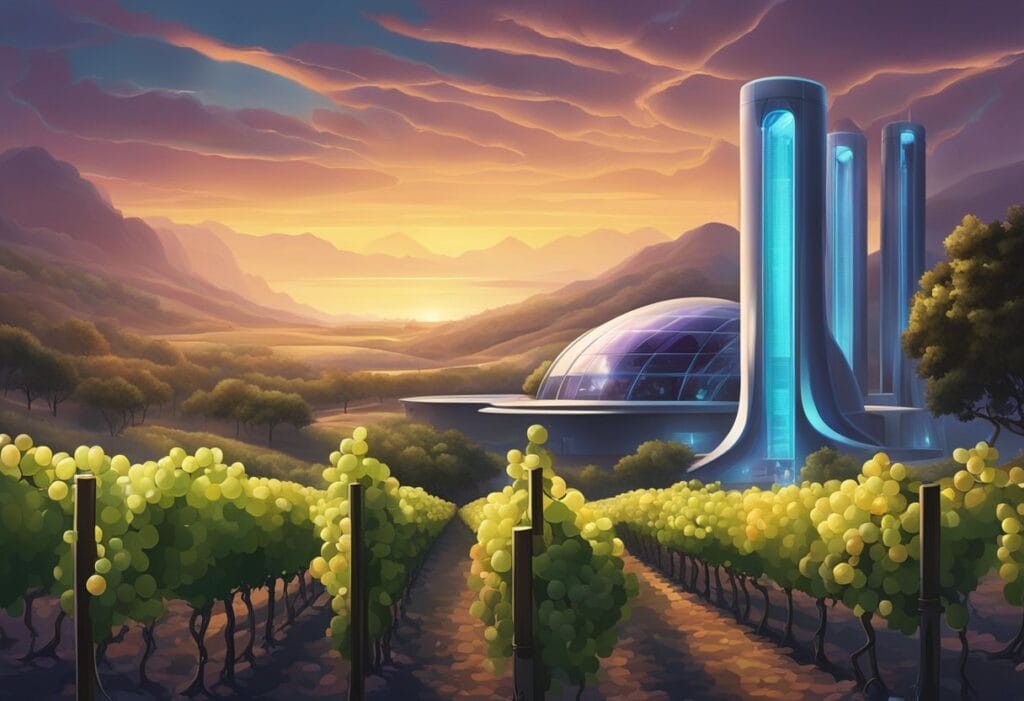
Climate change is reshaping wine production, compelling you and the industry to adapt to new growing conditions. As temperatures rise, traditional wine regions may become unsuitable for the varietals they’re known for. This shift opens doors for innovation in grape cultivation, leading to the development of heat-resistant varietals that maintain quality under new climatic stress.
Your appreciation for wine will need to include a consciousness of sustainability practices. Vineyards focusing on organic farming and water conservation are becoming more prominent. You’ll see more wines made from grapes like La Crosse and Nitodal, which offer drought tolerance and disease resistance, making them suitable for more sustainable viticulture.
Hybrid varietals are on the horizon, combining the best traits of different grapes to meet the challenges posed by changing environments. Expect wines that bring forth flavors that can thrive in diverse conditions, conserving resources while still satisfying your palate.
Innovation extends beyond the vineyard. Winemaking techniques will evolve, utilizing modern technologies to maximize efficiency and minimize environmental impact. Your choices in wine will soon reflect not just taste preferences but also a commitment to the planet’s health.
You’re looking forward to a future where wine varietals not only align with global palates but also with a global responsibility towards eco-friendly practices.
Culture and History of Wine
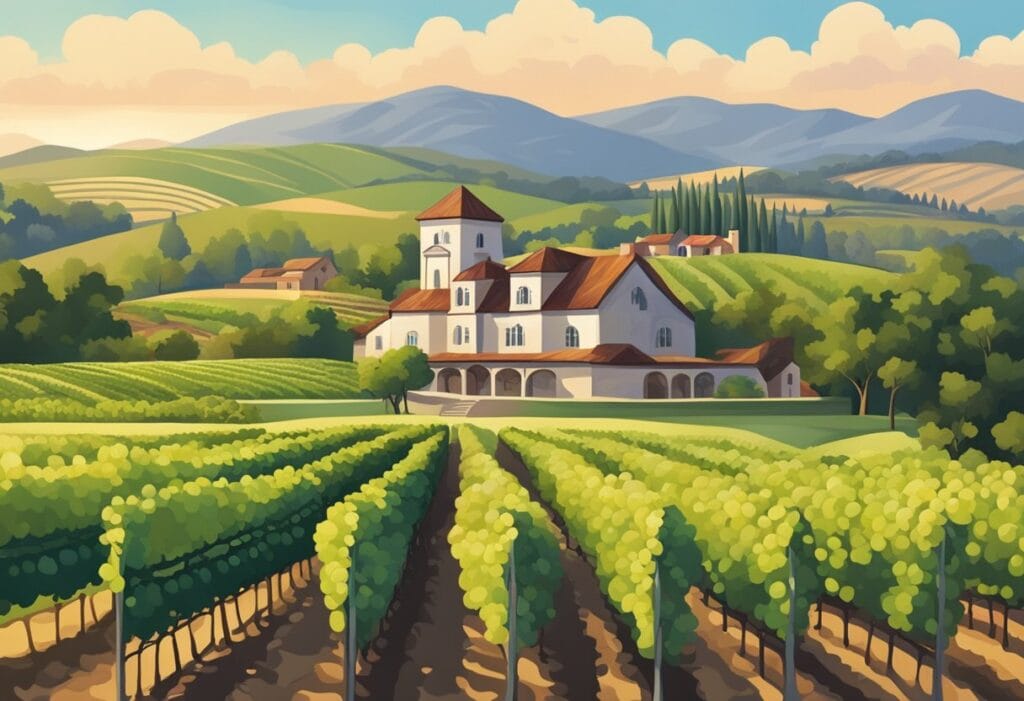
Wine has woven itself into the cultural tapestry of numerous civilizations over thousands of years. Your understanding of wine is incomplete without recognizing the tradition and cultural significance that has shaped its history. From ancient rites to social rituals, wine has been a symbol of prosperity and an accompaniment to great milestones in human history.
In ancient civilizations, like those in Mesopotamia, wine was more than just a beverage—it played a central role in religious ceremonies and was a treasured addition to the tables of the elite. Objects dating back to the early Mesopotamian era depict the winemaking process, indicating the long-standing significance of wine in human society.
- Middle Eastern artifacts: Scenes of grape processing and wine consumption.
- European vineyards: The cultivation of Vitis vinifera for wine production.
- Exploration and expansion: The spread of viticulture to the New World.
The earliest evidence of wine production dates back to Georgia (around 6000 BC) and Iran (5000 BC), with grape seeds found at archaeological sites. Wine’s journey across the globe is a tale of exploration, reflected in the voyages of Columbus that brought the winemaking tradition from the Old World to the New.
Wine has also been integral in shaping the culture and economy of regions like Europe, where French and Italian wines are celebrated globally. The cultivation of indigenous and imported grape varieties has given rise to a diverse array of wines, each with its unique characteristics and story.
Your appreciation for wine is enhanced when you consider the legacies of the regions like Chile, Argentina, and California—places where Spanish missionaries and European settlers extended the reach of viticulture.
Throughout history, wine has been a reflection of cultural identity and an essential component of tradition and celebration. As you explore different varietals, you’re not merely tasting a beverage; you’re experiencing a rich tradition that dates back millennia.
Advancements in Viticulture and Enology
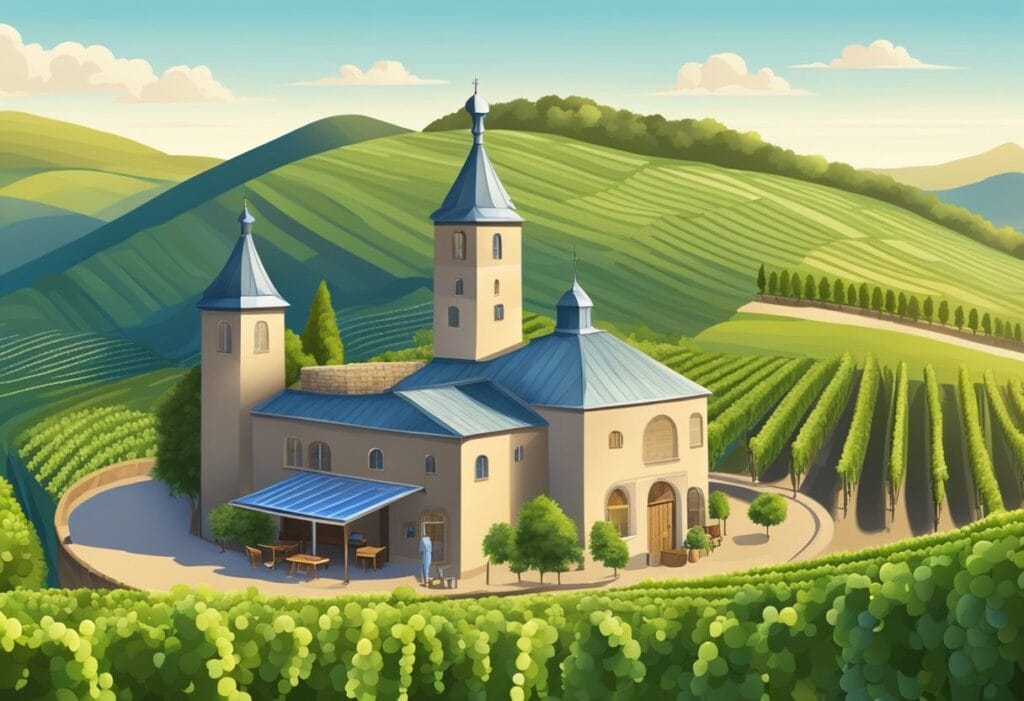
Recent years have seen impressive progress in the fields of viticulture and enology, broadly impacting the wine industry from grape to glass. Your understanding of wine varietals can be deepened by exploring these advancements.
In viticulture, genetic research has played a pivotal role. Scientists are developing new grape varieties that are not only resilient to climate change but also capable of producing high-quality wines. This includes breeding grapes with better resistance to pests and diseases, reducing the need for chemical interventions in your vineyard.
- Grape Breeding: Resistant varieties are developed through rigorous genetic research.
- Sustainable Practices: Introduction of innovative trellis systems and nutrient management strategies.
The field of enology has equally progressed, with nanotechnology being an exciting front for innovation. Nanoparticles and nanotechnology applications are being used to enhance wine quality and safety, by precisely targeting the treatment of wine and improving the specificity of aroma and flavor profile development.
- Wine Quality: Use of nanotechnology to improve safety and sensory properties.
- Fermentation: Advances in profiling free and bound monoterpene alcohols for more controlled fermentations.
Your winemaking practices can benefit from these strides by integrating nanotechnology in enology, giving you the power to refine wine on a molecular level, ensuring each bottle meets high standards of quality.
Utilizing advancements in viticulture and enology can potentially elevate your wine production, from grape breeding to the final sensory attributes of the wine you enjoy.
Professional Wine Education and Careers
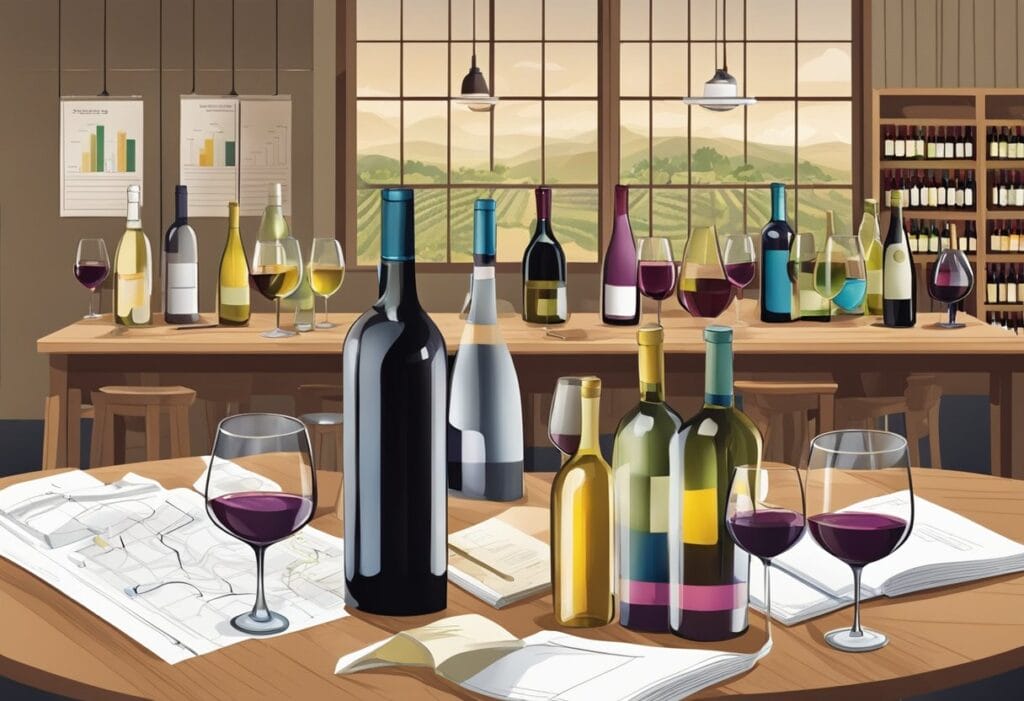
If you’re enthusiastic about wine, professional wine education can lead to diverse and fulfilling career opportunities. Educational programs often culminate in certifications that validate your expertise and open doors to roles like a sommelier or wine educator.
Wine Educator: As a wine educator, you will teach others about the vast world of wine. Your responsibilities could include conducting wine tastings, developing educational materials, and guiding future professionals. To excel, it’s advantageous to have credentials from esteemed institutions such as the Wine & Spirits Education Trust (WSET).
- Salary Range: Generally varies based on the institution or your private consultancy.
Sommelier: The journey to becoming a sommelier involves rigorous study of wine varieties, regions, service, and food pairings. A sommelier’s expertise is essential in fine dining establishments, helping guests to select the perfect wine.
- Salary Range: The income can be quite variable, based on the establishment and location.
Career Pathways:
- Vineyard Manager: Oversee vineyard operations and lead a team in the cultivation of grapes.
- Winery Sales Associate: Focus on customer service, wine presentation, and sales techniques.
- Wine Marketer: Use your knowledge to promote wine brands and educate consumers.
To pursue these careers, you should consider obtaining a recognized certification or degree in viticulture, enology, or wine business. Continual learning and staying current with industry trends is essential. Your passion for wine, when coupled with a solid educational foundation, can set the stage for a dynamic and rewarding wine career.
Wine Tourism and Tasting Experiences
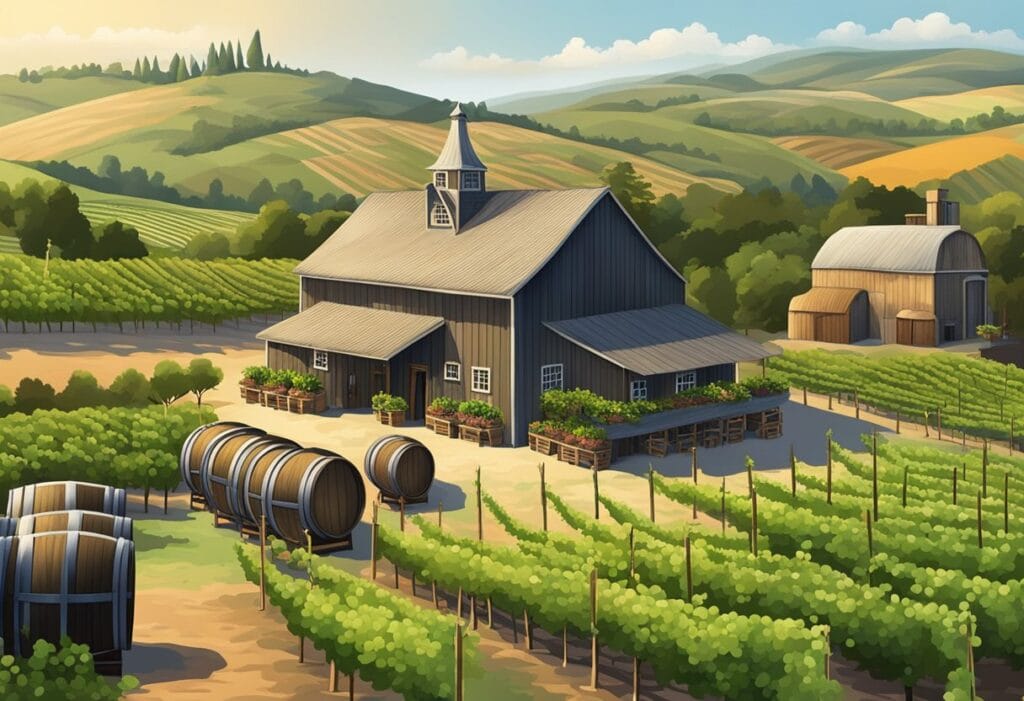
Wine tourism has become a significant part of the travel industry, inviting you to explore renowned wine-producing regions. These regions offer a wealth of vineyard tours, where you have the opportunity to walk through lush vineyards and learn about the winemaking process first-hand.
When planning your wine-focused vacation, consider the 8 Must-Visit Regions for Wine Tasting in the United States, which include celebrated destinations like Napa Valley and emerging locales rich with vineyard tours and wine-tasting experiences.
- Napa Valley, California: Known for its world-class Cabernet Sauvignons and picturesque scenery.
- Sonoma, California: Offers a diverse selection of wines and over 60,000 acres of vineyards.
During your visits, participate in wine tasting events, where you can savor a variety of wines and enhance your palate. These events are guided by knowledgeable sommeliers who provide insights into the flavors and history of each wine.
In addition to traditional tastings, look for unique experiences, such as the Yonah Mountain Vineyards Crush Fest in Georgia, which offers grape stomping and showcases the region’s finest offerings.
Remember to book vineyard tours ahead of time, as spots can fill up quickly, especially during peak seasons. Whether you prefer intimate boutique wineries or larger, more iconic vineyards, wine tourism caters to your taste and desire for adventure.
Wine Collecting and Investment
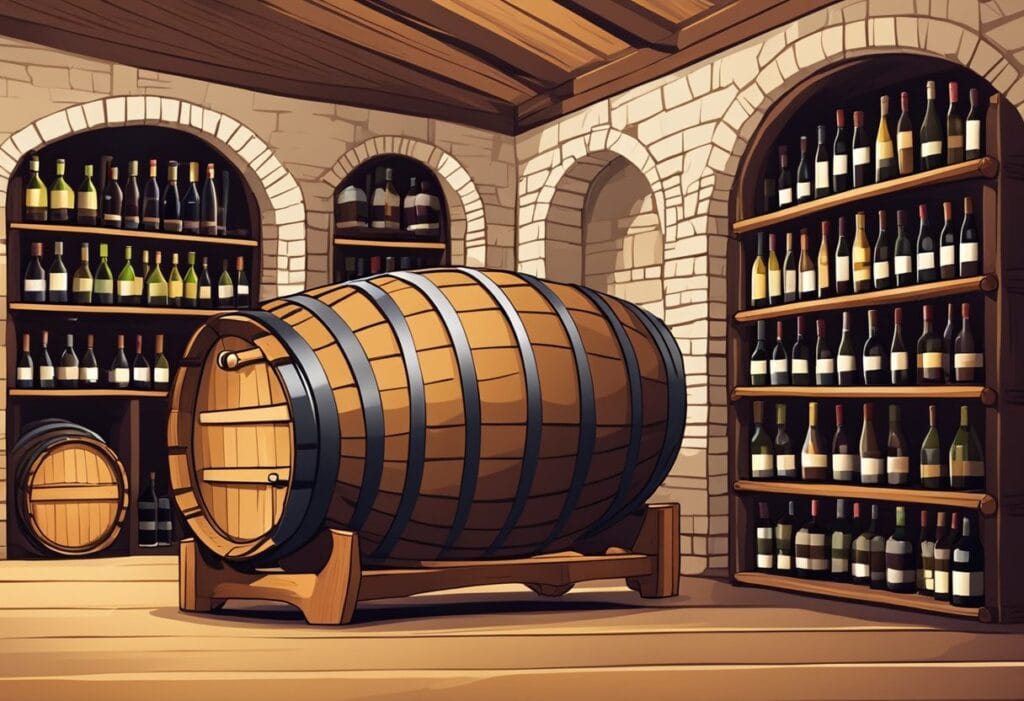
When you embark on the journey of wine collecting, recognize it as both a passion and investment. A well-curated wine collection can potentially offer significant financial returns. Quality wines that age well tend to increase in value over time, which is a key consideration when purchasing with investment in mind.
Start by focusing on investment-grade bottles that have a history of appreciating in value. For instance, fine red Bordeaux and prestigious labels from Burgundy are often sought after at auctions. Remember, the right conditions are essential for the storage of investment wines, as their quality and value are heavily dependent on it.
Here is what you need for a proper wine storage:
- Temperature control: Ideal range between 55°F and 58°F.
- Humidity: 70% is preferred to ensure corks don’t dry out.
- Darkness: Light can degrade the quality of wine over time.
- Stability: Minimal vibration to avoid disturbing the wine’s aging process.
Consider wine as a long-term investment. While some wines may see a quicker return, the best gains are often realized over many years. You should also diversify your portfolio with a mix of varietals and blends, which can provide both balance and coverage across different market demand and trends.
Keep meticulous records of your collection’s history and provenance, as these details are critical during resale and can significantly impact the wine’s value. Lastly, engage with wine communities and professionals to stay informed on market trends and opportunities.
Wine in Popular Media and Literature
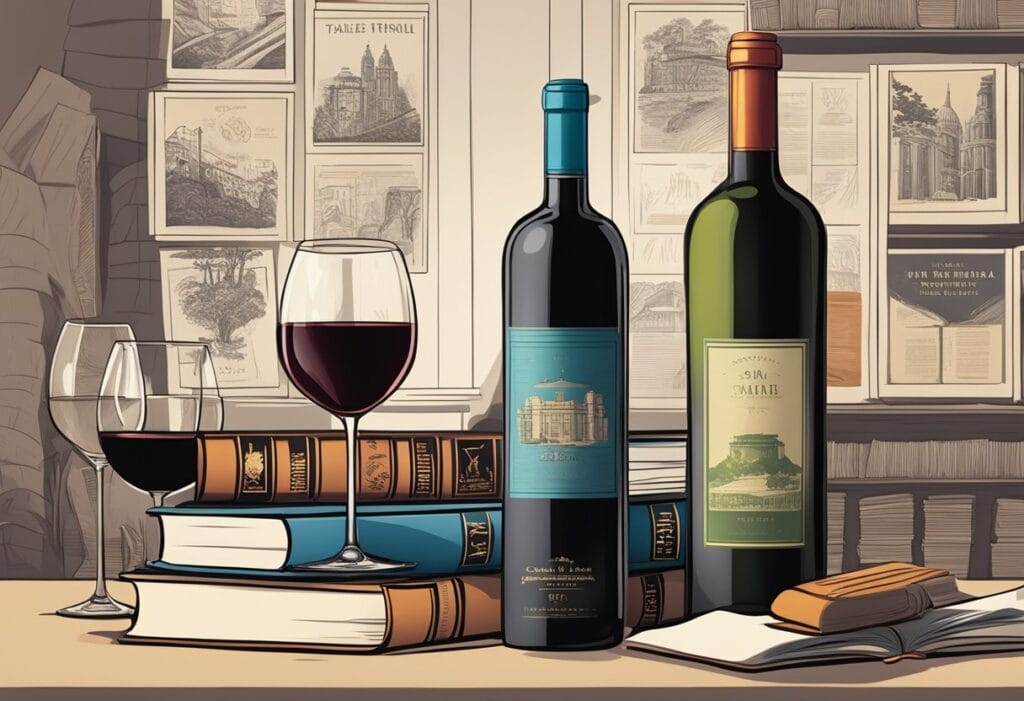
Wine often takes a central role in popular media and literature, underscoring its cultural significance. In movies and television shows, it’s not uncommon to see characters bonding over a glass of wine, symbolizing celebration, sophistication, or solace. For instance, wine-centric films like “Sideways” have notably affected consumer preferences, causing a spike in Pinot Noir’s popularity. This highlights the influence of media on public taste.
In literature, wine is a recurring motif suggesting festivity, wealth, or the simple pleasures in life. Historical texts, such as Geoffrey Chaucer’s Canterbury Tales, reference wine in the context of social settings and as a reflection of character’s tastes, layering the narrative with authenticity and detail (Wine & Literature – Napa Valley Wine Academy).
Contemporary books often mention specific wine varietals to set a scene or convey a character’s preferences, subtly indicating their sophistication or socioeconomic status. For example, a character might be portrayed enjoying a well-aged Bordeaux, implying a certain level of connoisseurship and luxury (Trending Wine Varietals and Why They Matter – FSR magazine).
Your understanding of wine can deepen through various media representations. Knowledgeable references to wine in films, books, and television can encourage you to explore new varietals or understand the nuances of wine regionality and production. These allusions not only enhance storytelling but also reflect and shape how society perceives and interacts with the world of wine.
Wine Clubs and Communities
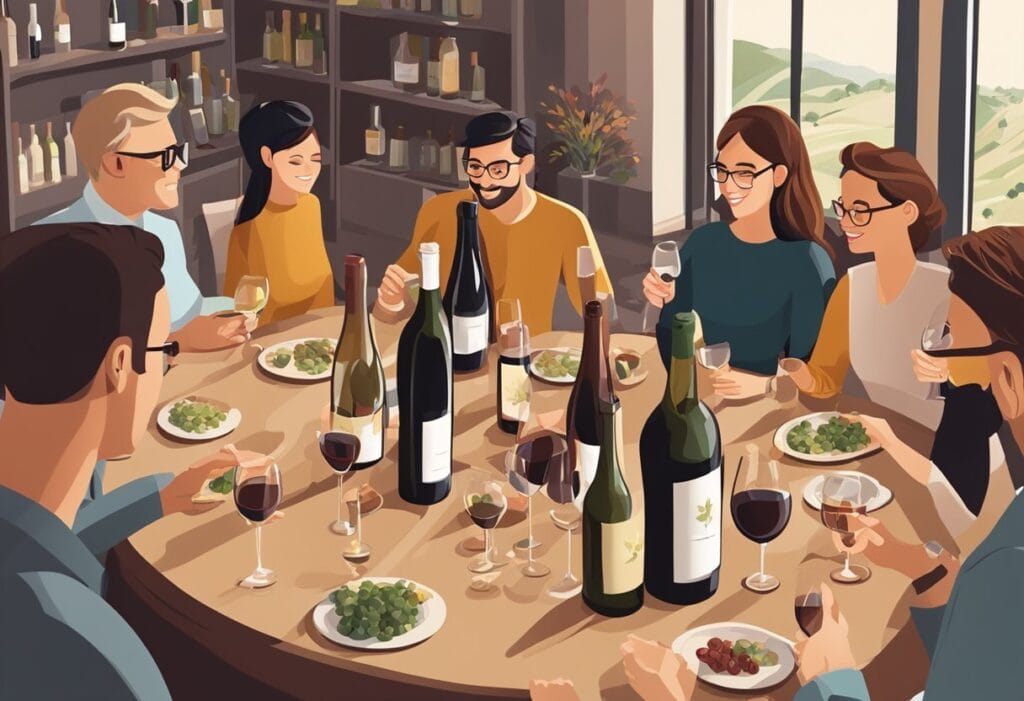
Wine clubs offer a unique blend of social interaction and education that caters to both seasoned aficionados and newcomers to the world of wine. By joining a wine club, you gain access to a curated selection of wines, often accompanied by notes that detail the characteristics and origins of each bottle.
- Social Aspect: Wine clubs are not just about the wine—they’re about the people. Meeting fellow members can transform your wine experience from a solitary activity into an engaging community event. Clubs often organize tastings, dinners, and even trips that foster a sense of camaraderie among members.
- Community Engagement: Wine clubs may focus on a range of interests and demographics, giving you the chance to join a community that shares your particular passion. For instance, some clubs concentrate on specific cultures or lifestyles, integrating wine education with cultural appreciation.
| Benefits of Wine Clubs |
|---|
| Tailored wine selection |
| Educational resources |
| Social events |
| Membership exclusives |
You’ll find that being part of a wine club enriches your understanding of wine in a collaborative environment. Through communal experiences like engaging discussions during a wine tasting or sharing insights on a new varietal, the shared knowledge and enthusiasm can be just as rewarding as the wines themselves.
Communities built within wine clubs can vary widely in their focus. Some are dedicated to exploring organic and biodynamic wines, while others may celebrate wines from a specific region or showcase limited-edition bottles. Regardless, they all serve to connect like-minded individuals through the love of wine.
Remember, when you’re exploring options for wine clubs, consider what aspects are most important to you—whether it be the variety of the wine, the expertise of the club’s advisors, or the type of social opportunities available.
Sustainability in the Wine Industry
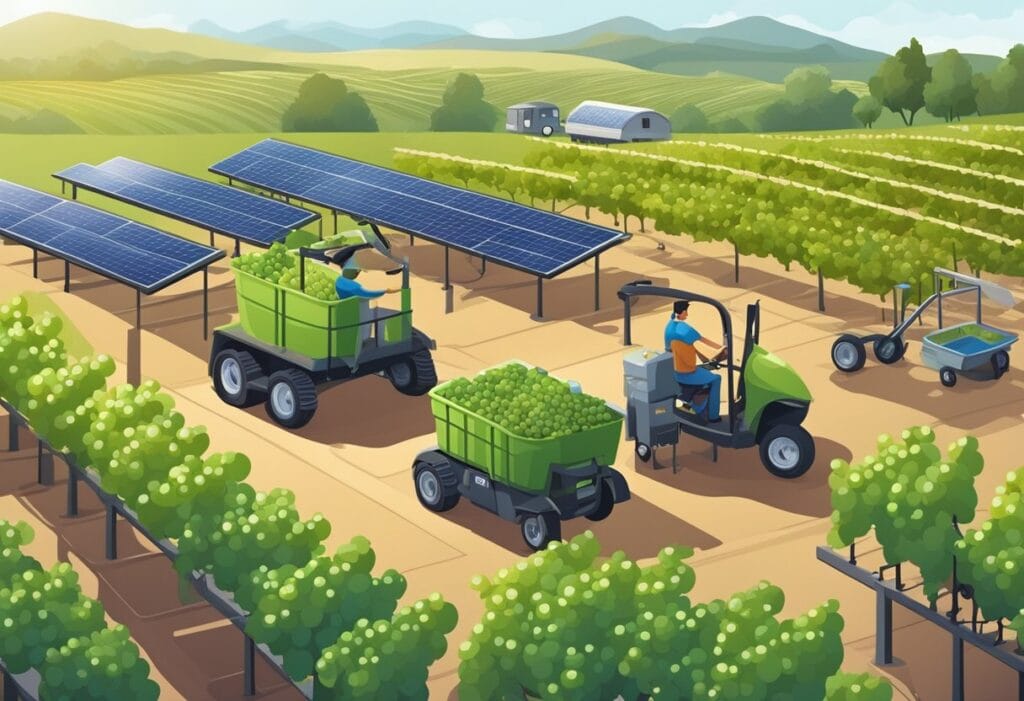
Sustainable winegrowing practices are crucial as they impact both the environment and the quality of the wine you enjoy. These practices are not only environmentally sound but also socially equitable and economically viable. They involve a combination of organic wine production, biodynamic practices, and eco-friendly approaches to viticulture and wine production.
When you choose organic wine, you’re opting for products made from grapes grown without synthetic pesticides or fertilizers. This method of wine production supports healthier soil and ecosystems.
Biodynamic wine takes things a step further, integrating organic farming methods with a holistic view of agriculture, where the vineyard is seen as an interconnected living system.
You might notice various certifications on wine labels indicating the eco-friendly measures taken by vineyards. These can include energy conservation, water management, and the use of renewable resources. Such practices aim to minimize carbon footprints and promote biodiversity, ensuring that you can enjoy fine wines for years to come.
It’s important to understand these certifications:
- Organic: No synthetic pesticides or fertilizers used
- Biodynamic: Farm treated as a single organism
- Sustainable: Broad approach, including social and economic factors
By supporting vineyards that implement sustainable practices, you contribute to a more responsible wine industry. Remember, choosing sustainably produced wine doesn’t just reflect your personal ethics; it actively promotes the longevity and health of the wine industry.
Frequently Asked Questions
In this section, discover the nuances that make each wine varietal unique and learn how to identify them by flavor, origin, and aroma.
What characteristics distinguish single-varietal wines from blends?
Single-varietal wines are made from one type of grape and aim to express the distinct characteristics and flavor of that grape, whereas blends combine multiple grape varietals to create a more complex and balanced taste profile.
What are some common white wine varietals and their flavor profiles?
Common white wine varietals such as Chardonnay often exhibit apple, pear, and tropical fruit notes, while Sauvignon Blanc is known for its grassy, herbal, and citrus flavors.
Can you list and describe 10 popular types of red wine varietals?
- Cabernet Sauvignon: Full-bodied with bold tannins and notes of dark fruits and spices.
- Merlot: Medium-bodied, soft tannins with berry and plum flavors.
- Pinot Noir: Light-bodied, with flavors of cherry, strawberry, and earthy notes.
- Syrah: Full-bodied, with bold fruit flavors and peppery hints.
- Zinfandel: Medium to full-bodied, with jammy fruit and spice.
- Malbec: Dark and full-bodied, with blackberry and chocolate notes.
- Sangiovese: Light to medium-bodied, with tart cherry and herbal flavors.
- Tempranillo: Medium-bodied, with notes of cherry, dried fig, and tobacco.
- Grenache: Light-bodied, with red fruit flavors and a sweet spice finish.
- Barbera: Medium-bodied with high acidity and flavors of cherry and red fruits.
How does the region of origin influence the taste of different wine varietals?
The region of origin, such as the soil, climate, and terrain or terroir, directly affects the grape’s characteristics and, in turn, the flavor, aroma, and texture of the wine produced from that varietal.
What are the primary differences between old world and new world wine varietals?
Old world wines, originating from Europe, are often more subtle and terroir-driven with higher acidity and lower alcohol, whereas new world wines from regions like the Americas and Australia are typically bolder, with more emphasis on ripe, fruit-forward flavors.
How can one identify a wine’s varietal based on tasting notes and aromas?
To identify a wine’s varietal, focus on the structural elements such as acidity, tannins, and body coupled with distinctive flavor profiles—like blackberry in Cabernet Sauvignon or peach in Viognier—and aroma notes, ranging from floral to earthy.
